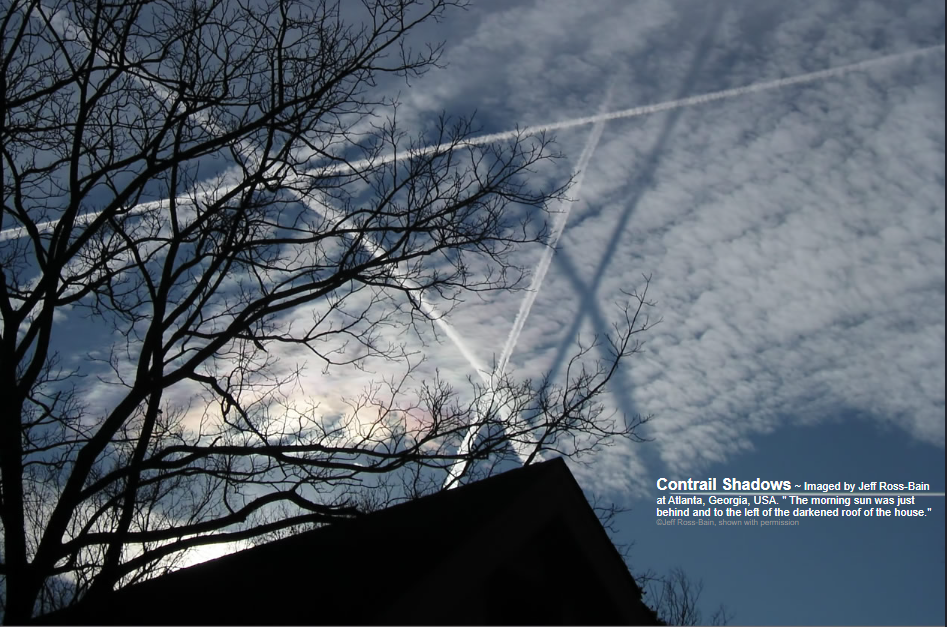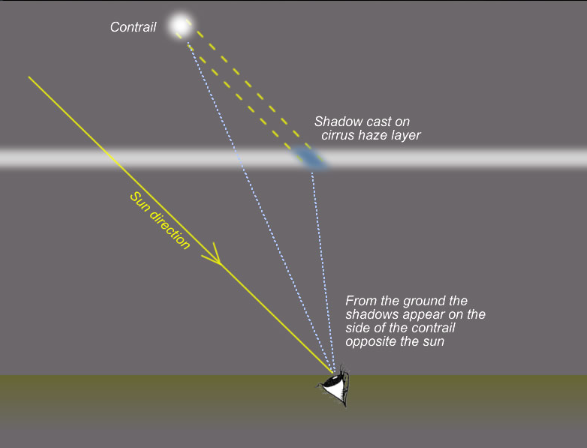OPOD - Crossed Contrail Shadows
OPOD - Crossed Contrail Shadows: A Fascinating Atmospheric Phenomenon
Have you ever witnessed crossed contrail shadows in the sky and wondered about the optical magic behind this captivating spectacle? Contrails, also known as condensation trails, are the visible trails left behind by aircraft as they pass through the atmosphere. These trails consist of ice crystals or water droplets that form around the aircraft's exhaust gases. While contrails are a common sight, crossed contrail shadows add an extra layer of intrigue to the atmospheric display.
When crossed contrails appear in the sky, they create a strong illusion that they are below the cloud layer and somehow casting shadows upwards. However, in reality, these crossed contrails are actually positioned above the clouds, shining brightly through them while casting their shadow seemingly further away from the sun. This optical phenomenon can leave us in awe and spark our curiosity about the science behind it.
To understand why crossed contrail shadows occur, we need to delve into the principles of light and atmospheric optics. When sunlight passes through ice crystals or water droplets in the atmosphere, it undergoes various interactions, including refraction, reflection, and scattering. These interactions play a crucial role in shaping the appearance of contrails and the resulting shadow patterns.
The crossed pattern of contrail shadows occurs when two or more contrails intersect each other at a certain angle relative to the observer's position. As sunlight passes through these intersecting contrails, it gets scattered and refracted in different directions. This scattering and refraction of light create an intricate play of shadows and highlights, giving the impression that the contrails are casting their shadows upwards.
Interestingly, the clouds close to the sun often exhibit hints of iridescence when crossed contrail shadows are present. Iridescence refers to the phenomenon where certain surfaces or substances appear to change color when viewed from different angles. In this case, the interaction of sunlight with the ice crystals or water droplets in the clouds can lead to the scattering of light at different wavelengths, resulting in the vibrant display of colors.
The illusion of crossed contrail shadows can be particularly striking when the sun is low on the horizon. During sunrise or sunset, the angle at which sunlight passes through the atmosphere is much shallower, allowing for a greater interaction with the contrails and clouds. This enhances the visual effect of the crossed contrail shadows and intensifies the overall atmospheric spectacle.
It's important to note that the appearance of crossed contrail shadows can vary depending on several factors, including the altitude and density of the clouds, the position of the observer relative to the contrails, and the angle of sunlight. These variables contribute to the unique and ever-changing nature of this atmospheric phenomenon.
In conclusion, crossed contrail shadows present a fascinating display of optical illusions in the sky. The interplay of sunlight, contrails, and clouds creates a mesmerizing spectacle that captures our imagination. Understanding the principles of light and atmospheric optics helps us appreciate the beauty and complexity behind this captivating phenomenon. So, keep your eyes to the sky, and you may just witness this enchanting display of crossed contrail shadows.

Contrail Shadows ~ Imaged by Jeff Ross-Bain at Atlanta, Georgia, USA. " The morning sun was just behind and to the left of the darkened roof of the house." ©Jeff Ross-Bain, shown with permission

These crossed contrails create the strong illusion that they are below the cloud layer and somehow casting shadows upwards.
They are above the clouds and shining brightly through them while casting their shadow apparently further away from the sun.
The clouds close to the sun show hints of iridescence.
Note: this article has been automatically converted from the old site and may not appear as intended. You can find the original article here.
Reference Atmospheric Optics
If you use any of the definitions, information, or data presented on Atmospheric Optics, please copy the link or reference below to properly credit us as the reference source. Thank you!
-
<a href="https://atoptics.co.uk/blog/opod-crossed-contrail-shadows/">OPOD - Crossed Contrail Shadows</a>
-
"OPOD - Crossed Contrail Shadows". Atmospheric Optics. Accessed on November 26, 2024. https://atoptics.co.uk/blog/opod-crossed-contrail-shadows/.
-
"OPOD - Crossed Contrail Shadows". Atmospheric Optics, https://atoptics.co.uk/blog/opod-crossed-contrail-shadows/. Accessed 26 November, 2024
-
OPOD - Crossed Contrail Shadows. Atmospheric Optics. Retrieved from https://atoptics.co.uk/blog/opod-crossed-contrail-shadows/.